

Position Statement on the Role of the School Library Program. Learning for life…whether the focus is on readiness for the next grade or college and career readiness, the school library program plays a crucial role in preparing students for informed living in the 21st century.
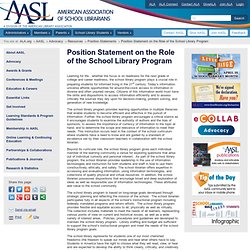
Today’s information universe affords opportunities for around-the-clock access to information in diverse and often unjuried venues. Citizens of this information world must have the skills and dispositions to access information efficiently and to assess critically the sources they rely upon for decision-making, problem solving, and generation of new knowledge. The school library program provides learning opportunities in multiple literacies that enable students to become efficient and effective in the pursuit of information. Beyond its curricular role, the school library program gives each individual member of the learning community a venue for exploring questions that arise out of individual curiosity and personal interest. Position Statement on the School Librarian's Role in Reading. Rationale: Reading is a foundational skill for 21st-century learners.
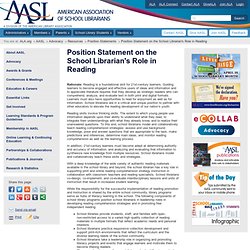
Guiding learners to become engaged and effective users of ideas and information and to appreciate literature requires that they develop as strategic readers who can comprehend, analyze, and evaluate text in both print and digital formats. Learners must also have opportunities to read for enjoyment as well as for information. School librarians are in a critical and unique position to partner with other educators to elevate the reading development of our nation’s youth.
Reading skills involve thinking skills. The extent to which young people use information depends upon their ability to understand what they read, to integrate their understandings with what they already know, and to realize their unanswered questions. Meeting Readers Where They Are: Mapping the intersection of research and practice.
Gale Power Search - Document. Gale Power Search - Document. Gale Power Search - Document. Gale Power Search - Document. Gale Power Search - Document. Position Statement on Labeling Books with Reading Levels. Librarians use spine labels to organize and identify library resources by call number to help patrons locate general subject areas or specific fiction, non-fiction, reference, audiovisual, or other items.
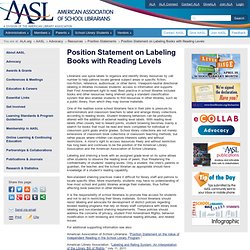
Viewpoint-neutral directional labeling in libraries increases students’ access to information and supports their First Amendment right to read. Best practice in school libraries includes books and other resources being shelved using a standard classification system that also enables students to find resources in other libraries, such as a public library, from which they may borrow materials. One of the realities some school librarians face in their jobs is pressure by administrators and classroom teachers to label and arrange library collections according to reading levels. Student browsing behaviors can be profoundly altered with the addition of external reading level labels. Position Statement on the Value of Independent Reading in the School Library Program.
In an information age, literacy demands not only the ability to read and write, but also the ability to process information and communicate effectively.
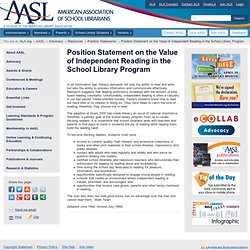
Research suggests that reading proficiency increases with the amount of time spent reading voluntarily. Unfortunately, independent reading is often a casualty in our fast paced, media-oriented society. Today's students know how to read but have little or no interest in doing so. They have failed to catch the love of reading; therefore, they choose not to read. The adoption of Goals 2000 has made literacy an issue of national importance; therefore, a primary goal of the school library program must be to create life-long readers. To become life-long readers, students must have . . . The man who does not read good books has no advantage over the man who cannot read them. (adopted June 1994; revised July 1999) AASL Conference 2011: Colorado Elementary School Ditches Dewey for Bookstore Model. Restricted Access to Library Materials: An Interpretation of the Library Bill of Rights.
Libraries are a traditional forum for the open exchange of information.
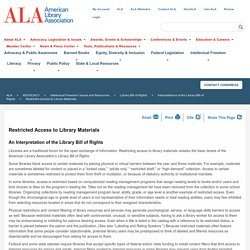
Restricting access to library materials violates the basic tenets of the American Library Association’s Library Bill of Rights. Some libraries block access to certain materials by placing physical or virtual barriers between the user and those materials. For example, materials are sometimes labeled for content or placed in a “locked case,” “adults only,” “restricted shelf,” or “high-demand” collection. Access to certain materials is sometimes restricted to protect them from theft or mutilation, or because of statutory authority or institutional mandate.